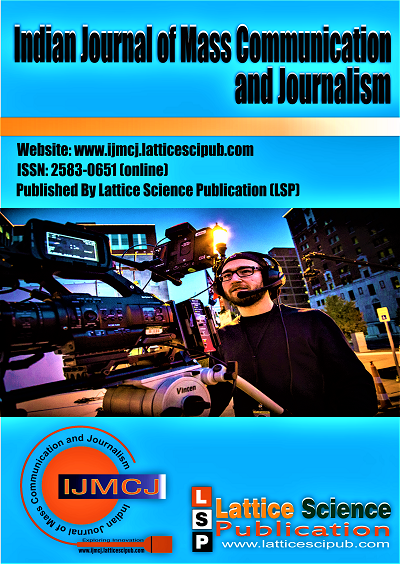Community Documentary: Move Towards Digital Inclusion
Main Article Content
Abstract
This research paper looks at the dynamics of digital divide and the potential of community documentaries to challenge them. Researcher critically reviewed the literatures on community media initiatives and result of such media exposures. This research work considers the Community video works as Cinẻma Pur and put forward some theoretical understanding to define the term documentary from the basic idea of visual documentation, with an attempt to establish any kind of community visual documentation as documentary work and thus provides a theoretical reference to such documentation as Community Documentary, nullifying the much used alternative expression of Community Video. Influences of such Community Documentaries and their making process on the women are further elaborated from gender perspective. Researcher looks at the potential of these documentary making procedures taken up for, of and by the community women, with and without technical supports from outside agencies, as a step forward to bridge the digital divide. Ensuring the access and skill to use the Information and Communication Technologies (ICT), making process of community documentaries enabled the community women to participate and get benefited from growing knowledge and information society. All the three aspects of digital inequalities, better known as digital divides: 1.Economic divide or infrastructural inequality 2.Usability divide or inequality in digital literacy 3.Empowerment divide or participation inequality, are stressed while examining whether community documentaries can serve as a type of digital inclusion. Theoretical base of the model is being scrutinized by three case studies taken up in the Indian state of Gujrat and Andhra Pradesh: 1.’Gender Sensitive Governance through ICT’ by Mahila Swaraj Manch, Shihore-a project base for ‘Making Women’s Voice and Votes Count’ –a multi-site project funded by UN Women, 2. ‘Ek Poltun Bheek Nu’ by the community women of Narmadapura, Baroda and 3.‘When Women Unites’ by the community women of Nellore.
Downloads
Article Details

This work is licensed under a Creative Commons Attribution-NonCommercial-NoDerivatives 4.0 International License.
How to Cite
References
Abbott, C. (2010). E-inclusion: learning difficulties and digital technologies. Kings College. https://spectronics.com.au/conference/2010/pdfs/E-inclusion%20-%20Learning%20Difficulties%20and%20Digital%20Technologies.pdf 2. A, Sharma. (2012). Role of Community Radio for Women’s Empowerment. The New Media and Development Netwrok. https://www.comminit.com/media-development/content/role-community-radio-women%E2%80%99s-empowerment 3. Association for Learning Technology. (2009). Delivering Digital Inclusion:A response to the consultation from the Association for Learning Technology. https://www.alt.ac.uk/sites/default/files/assets_editor_uploads/documents/Delivering_Digital_Inclusion_ALT_response_to_consultation. 4. Buckley, S. (2011). Community Media: A Good Practice Handbook. UNESCO. 5. Cherniss, L. (2015). Want to Change the Face of Technology? Look to Our Girls,. Huffington Post. http://www.huffingtonpost.com/techbridge-girls/want-to-change-the-face 6. Ching, C., Basham, J., & Jang, E. (2005). The legacy of the digital divide: Gender, socioeconomic status and early exposure as predictors of full-spectrum technology use in young adults. Urban Education, 40(4), 394–411. https://www.researchgate.net/publication/258198540_The_Legacy_of_the_Digital_Divide_Gender_Socioeconomic_Status_and_Early_Exposure_as_Predictors_of_Full-Spectrum_Technology_Use_Among_Young_Adults [CrossRef] 7. Djik, J. A. G. M. V. (2005). The Deepening Divide: Inequality in the Information Society. University of Twente, Netherlands. 8. Govt. of India. (2007). Community Radio in India: A Guide for Civil Society. UNESCO. 9. Geiger, J. & Rutsky R.L.(2005).Film Analysis. WW Norton 10. Goldmann, A. (1971). Cinema et Societe Moderne: Le Cinema De 1958 A 1968, Godard, Antonioni, Resnais, Robbe-Grillet (Sociologie Et Connaissance Series). Anthropos. 11. Mahanta, M., & Rowmuria, S. (2016). Community Documentary : A Move towards Gender Bridging. Human Rights International Research Journal, 4(1), 15–25. 12. Musubika, J. (2008). Community media and the empowerment of rural women in Uganda: a study of Mama Fm Radio. UIO. https://www.duo.uio.no/bitstream/handle/10852/27710/Musubika.pdf?sequence=2&isAllowed 13. OECD. (2018). Bridging the Digital Gender Divide: Include, Upskill, Innovate. Organisation for Economic Co-operation and Development. https://www.oecd.org/digital/bridging-the-digital-gender-divide.pdf 14. Seale, J., & Dutton, W. (2012). Empowering the digitally excluded: Learning initiatives for (in)visible gro. Research in Learning Technology, 20(2012), 313–321. https://www.researchgate.net/publication/276229965_Empowering_the_digitally_excluded_Learning_initiatives_for_invisible_groups [CrossRef] 15. Selwyn, N. (2006). Digital division or digital decision? A study of non-users and low-users of computer. Poetics, 34, 273–292. https://www.researchgate.net/publication/223670508_Digital_division_or_digital_decision_A_study_of_non-users_and_low-users_of_computers [CrossRef] 16. Selwyn, N. (2004). Reconsidering political and popular understandings of the digital divide. New Media & Society, 6(3), 341–362. https://journals.sagepub.com/doi/10.1177/1461444804042519 [CrossRef] 17. Skuse, A., Fildes, J., Joann, T., Martin, K., & Baluch, E. (2007). Poverty and Digital Inclusion:Preliminary Findings of Finding a Voice Project. UNESCO. http://www.unesco.org/new/en/communication-and-information/resources/publications-and-communication-materials/publications/full-list/poverty-and-digital-inclusion-preliminary-findings-of-finding-a-voice-project/ 18. Stalin, K. (2011). Project report of Building Institutional Capacity of community Radio Forum, to Strengthen Marginalized Voices And Good Governance. UNESCO & Community Radio Forum. 19. The Female/male Digital Divide: Media and Entertainment. (2014). Https://Www.Nielsen.Com/ca/En/Insights/Article/2014/the-Female-Male-Digital-Divide/. https://www.nielsen.com/ca/en/insights/article/2014/the-female-male-digital-divide/





